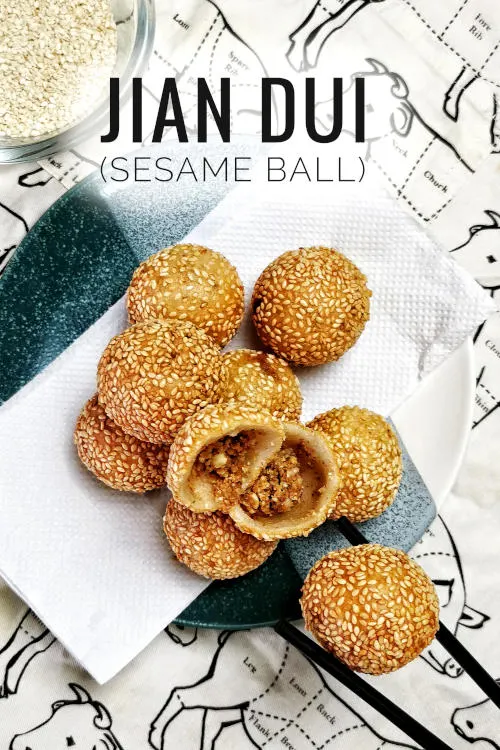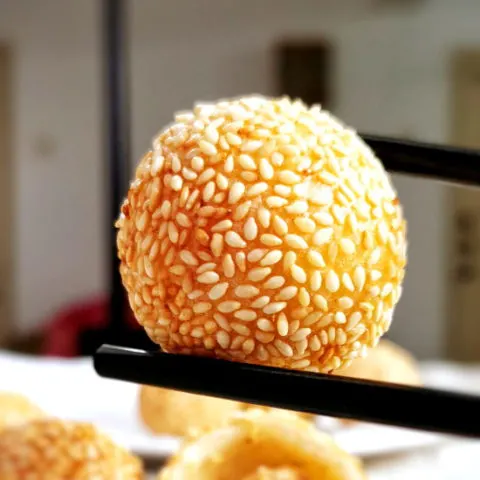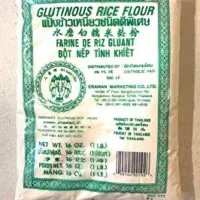Jian dui (sesame ball/ 麻团 /煎堆 / 芝麻球) is a well-known fried Chinese pastry made from glutinous rice flour. This delectable dessert is coated with sesame seeds on the outside, which are crisp and chewy. It encases a sweetened filling consisting of red bean, peanut, or lotus paste. Cheese and chocolate are some innovative fillings for these same balls.
I made the sesame balls with my favorite peanut paste filling, the most popular variant. This variant is widely available in Malaysian street food stores.
Note: This post may contain affiliate links. Please read my privacy policy for more info. I may receive commissions for purchases made through links in this post. As an Amazon Associate, I earn from qualifying purchases.

📝 Ingredients required to make Jian Dui (Sesame Balls)
- The correct ingredient is glutinous rice flour, not regular rice flour. Glutinous rice flour is far more sticky and is the right ingredient.
- I used peanut paste as the filling, a combination of crushed peanuts, peanut butter, and honey. The mixture comprises 75g of crushed peanut butter, 30g of smooth peanut butter, and 30g of honey. You may want to use sugar instead of honey to make it sweeter or add more peanut butter for a softer peanut paste. The advantage of making it at home is that you can adjust the ratio of each ingredient yourself.
Note: The filling of the sesame balls is usually a sweet paste. Besides peanut paste, other typical fillings are lotus seed paste, and red bean paste. In addition, cheese and chocolate are innovative fillings for these same balls. Store-bought lotus paste and red bean paste are readily available where I live. Of course, you can adjust the sweetness if you make it yourself, but most bakers use the store-bought one because it saves time.
👉 How to make sesame balls (Jian Dui)
Here are the details of my Jian Dui recipe.
1. Make the Jian Dui dough
- The first step in making the Jian Dui dough is to prepare the syrup by dissolving the sugar in boiling water in a small pot. I add the hot water from my thermos to the sugar, and it works well as the castor sugar dissolves completely with just a few stirs.
- You might notice some recipes that add raw sugar and water directly into the glutinous rice flour to form the dough. I believe it works, although I choose to make the syrup first, which is the method that I am familiar with.
- Measure the glutinous rice flour as indicated in the recipe, then add the warm syrup and knead it to become a dough.
- Initially, the flour and syrup do not form a cohesive dough. However, it will slowly stick together and pick up the flour in the bowl. Once the dough is soft and malleable, set aside and cover it with a moist cloth for thirty minutes before continuing to work on it.
2. Prepare the filling for Jian Dui
- Mix the crushed peanuts, smooth peanut butter, and honey to form the peanut paste as the filling. Divide the filling to 13g each. The weight of the filling I use is half of the dough. You can use more if you are good at wrapping the filling within the dough.
3. Wrap the filling with the dough
- Roll a portion of the dough (25g to 30g) between your palms. If you find it too dry, wet one of your palms with water before rolling it.
- Make a dent at the center of the dough, then continue pinching with your fingers to shape it like a tiny teacup. Try to make the thickness of the cup evenly and ensure that the depth is at least enough to hold the filling.
- Place one ball of filling inside the ‘teacup.’
- Hold it with your thumb and index finger, working the dough upward to cover the filling while turning it slowly.
- When the dough is about to cover the filling, wet the edge of the seam, pinch and seal the dough.
- Roll it between your palms until the seam is no longer noticeable.
4. Coat with sesame seeds
- Use one hand to dip the sesame ball into the water and immediately remove it.
- Shake off the excess water. The wet surface of the dough helps to stick the sesame seeds securely on it.
- Transfer it into a bed of white sesame seeds with the other hand which is dry.
- When the surface is coated with sesame seeds completely without bare spots, press the sesame ball lightly to ensure all the seeds have firmly adhered to the surface. Otherwise, they will fall off while deep-frying.

4. Deep-fry the sesame balls
Deep-frying is the most crucial step in making sesame balls, requiring proper temperature control and constant stirring.
a. Start with low temperature
- Heat the oil between 120°C/250°F and 130°C/265°F.
- Place the sesame balls into the oil. Please remember that the size of the sesame ball will increase in the process. Therefore, do not deep-fry too many, making the pan too crowded.
- Be gentle, as you do not want it to splash. My method is to glide the sesame balls into the oil with chopsticks.
- The sesame balls will sink to the bottom initially. At this point, keep stirring gently to move them to avoid sticking to the bottom. After a minute, the outer part of the sesame balls starts to cook and will no longer be sticky.
- The sesame balls will float to the top after three to four minutes (depending on the size and temperature).
- After about four minutes, the sesame balls will start floating on the surface. Use a slotted spoon or wire mesh strainer to press them down lightly to submerge them in the oil. This step helps the sesame balls cook uniformly into a spherical shape. The balls will bounce back to the top quickly and get bigger as time passes. Finally, they will expand to the maximum size, which takes about six to eight minutes.
- The temperature should be kept as low as before while the inside still expands. The sesame balls can burst/explode if you use high heat, which causes them to expand too fast.
b. Increase the temperature to make them turn golden
- Once the sesame balls are fully expanded, which takes about six minutes for the size in this recipe, they will become hollow and light. At this point, half of the balls will float above the oil surface.
- Now, turn the heat to 170°C/335°F. Continue pushing them around in the oil to ensure they are evenly cooked.
- It will take another two to four minutes until they become golden. Once golden, place them on a paper towel to absorb the excess oil.
Note: The total frying time takes about 12 to 15 minutes. The surface will become crispy and firm eventually and will not shrink after cooling. This method ensures the sesame balls puff up fully. When one correctly, they will expand to 1.5 to 2x the original size. The outer layer is crispy but still soft and chewy on the inside. You can hear the hollow sound when you shake it because the filling has detached from the outer layer.
🆒 How to keep sesame balls
Sesame balls are best to eat while fresh when the outer surface is still slightly crispy. You can keep them in an airtight container and store them in the refrigerator. When you want to serve, reheat in the oven at 170°C/335°F for 7-8 minutes or until the outside is crisp.
✍️ Cook’s note: How much syrup should I use?
I use 40g of sugar for every 100 ml of water to make the syrup. This amount is for 140g of glutinous rice flour. This ratio of ingredients works well. If the amount of water is too little, the dough will crack when you use it to wrap the filling. On the contrary, the dough will not hold its shape if it is too soft, and the final result is a flattened ball instead of a perfect sphere.
However, please take note the amount can vary because the amount of water required by different brands of glutinous rice flour can vary. Moreover, it also depends on humidity and temperature. Therefore, you can add a small amount of water, two teaspoons each time, into the dough if it is too hard and cracks easily. Otherwise, add one tablespoon of glutinous rice flour each time if it is too soft to work with.
💡More tips to make sesame balls successfully
- The trick to wrapping the Jian Dui is to use one hand to dip the sesame balls in the water and the other hand to roll them in the bowl of sesame seeds. This method will ensure one hand is always dry so you can work on the next sesame ball neatly.
- Some sesame ball recipes include wheat starch and vegetable oil in the recipe. Wheat starch helps make the texture of the dough less sticky, while the oil helps bind the dough together. I did try to include them, but I am happy with a basic recipe without these ingredients, which works well.
- I suggest using a digital weighing scale for a more accurate measurement unless you are already an expert. The final size of the sesame balls is about what is sold in most stores here if you portion it to 25g to 30 g each.
- Once you divide the dough into small portions with a dough cutter, smoothen them by rolling them between your palms and covering them at all times to prevent them from drying.
- If the temperature is too high, the outer part of the dough will set quickly and tend to crack while the inside starts to inflate. You can use a slightly higher temperature, but it should always be safer to keep it low if you do not have a kitchen thermometer. I use it to ensure the oil temperature is kept between these temperatures.
- The best way to move the sesame balls around in the first minute is to use a slotted metal spoon or a wire mesh strainer. Glide the slotted pan along the bottom of the pan while stirring instead of pushing the balls around midway. This method can prevent the sesame seeds from detaching from the same balls.
- Remove any burst sesame ball immediately, if any. This way, it can prevent the filling of the burst ball from scattering into the oil.
- If there is any white spot on the sesame ball that doesn’t turn golden, keep that pale spot in the oil with the help of the chopsticks so it crusts over.

Sesame ball - How to make perfect Jian Dui at home
Sesame ball (Jian dui / 麻团 /煎堆 / 芝麻球) is a well-known fried Chinese pastry made from glutinous rice flour. This delectable dessert is coated with sesame seeds on the outside which are crisp and chewy. It encases a sweetened filling consisting of red bean paste, peanut paste, or lotus paste.
Ingredients
- 100ml hot water
- 40g sugar
- 140g glutinous rice flour
- 1/4 bowl of white sesame seeds
- 75g crushed peanuts
- 30g smooth peanut butter
- 2 tbsp honey
Instructions
- Dissolve the sugar in hot water to make a syrup. Add the warm syrup to the glutinous rice flour and knead it into the dough.
- Once the dough is soft and malleable, divide it into portions of 25g each.
- Smoothen them by rolling them between your palms and covering them at all times to prevent them from drying.
- Mixed the crushed peanuts, smooth peanut butter, and honey to form the peanut paste as the filling. Divide the filling to 13g each.
- Roll a portion of the dough between your palm to make it spherical. If you find it too dry, wet one of your palms with some water before rolling it.
- Make a dent at the center of the dough, then continue pinching with your fingers to shape it like a tiny teacup.
- Place one ball of filling inside the ‘teacup.’
- Wet the edge of the dough and pinch and seal the dough. Roll it between the palms until the seam is no longer noticeable.
- Deep the dough into water, shake off the excess. Transfer into a bed of white sesame seeds in a bowl and cover the surface thoroughly.
- Press the sesame ball lightly to ensure all the sesame seeds have adhered to the surface firmly.
- Heat the oil to 120°C/250°F. Deep-fry the sesame balls for 4 minutes until they start to float to the top. Stir to avoid sticking.
- Use a slotted spoon or wire mesh strainer to press them down lightly to submerge them in the oil, for about six to eight minutes until they expand to the maximum size.
- Turn the heat to 170°C/335°F. Deep-fry another two to four minutes until they become golden.
- Place them on a paper towel to absorb the excess oil. Serve.
Recommended Products
As an Amazon Associate and member of other affiliate programs, I earn from qualifying purchases.
-
 Pro Dough Pastry Scraper/Cutter/Chopper Stainless Steel Mirror Polished with Measuring Scale Multipurpose- Cake, Pizza Cutter - Pastry Bread Separator Scale Knife (1)
Pro Dough Pastry Scraper/Cutter/Chopper Stainless Steel Mirror Polished with Measuring Scale Multipurpose- Cake, Pizza Cutter - Pastry Bread Separator Scale Knife (1) -
 McCormick Gourmet Collection Toasted Sesame Seed, 15 Ounce
McCormick Gourmet Collection Toasted Sesame Seed, 15 Ounce -
 Glutinous Rice Flour 1 LB x 20 Bags 水磨白糯米𥺃粉
Glutinous Rice Flour 1 LB x 20 Bags 水磨白糯米𥺃粉 -
 Chef Craft Seturmelect Heavy Duty Slotted Spoon, 12 inch, Stainless Steel
Chef Craft Seturmelect Heavy Duty Slotted Spoon, 12 inch, Stainless Steel
Nutrition Information:
Yield: 10 Serving Size: 1Amount Per Serving: Calories: 185Total Fat: 8gSaturated Fat: 1gTrans Fat: 0gUnsaturated Fat: 6gCholesterol: 0mgSodium: 47mgCarbohydrates: 24gFiber: 2gSugar: 8gProtein: 5g
This data was provided and calculated by Nutritionix on 11/13/2021

HC
Wednesday 22nd of March 2023
Hey KP, thanks for the insights in making this Malaysian classic. There are not much content about Malaysian food in the internet and I hope you can keep up the good work in promoting and preserving our food culture.
KP Kwan
Saturday 13th of November 2021
Hi, this is KP Kwan. I am happy to see you in this comment area, as you have read through my recipe. I am glad to reply to any questions and comments as soon as possible.